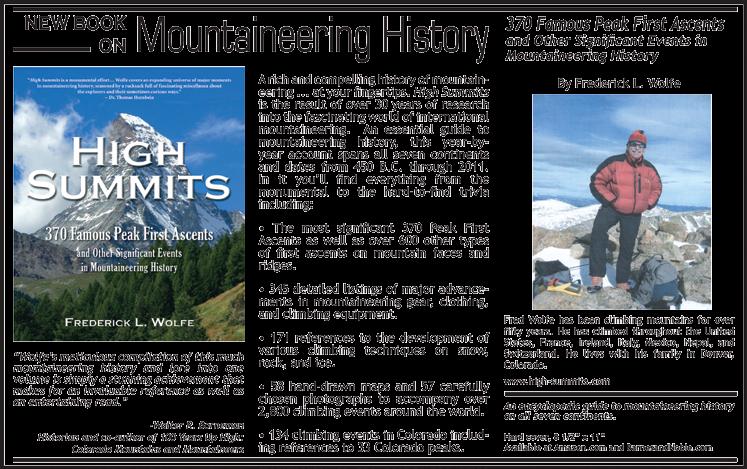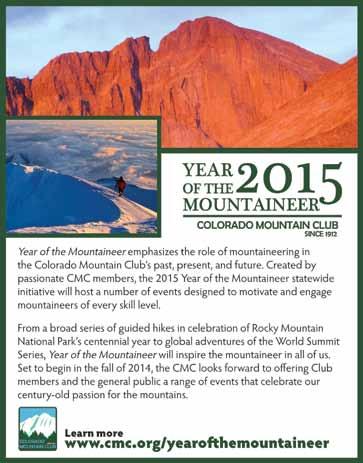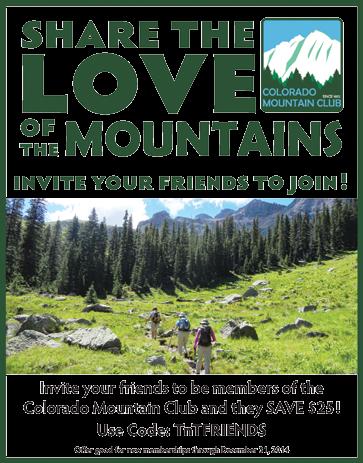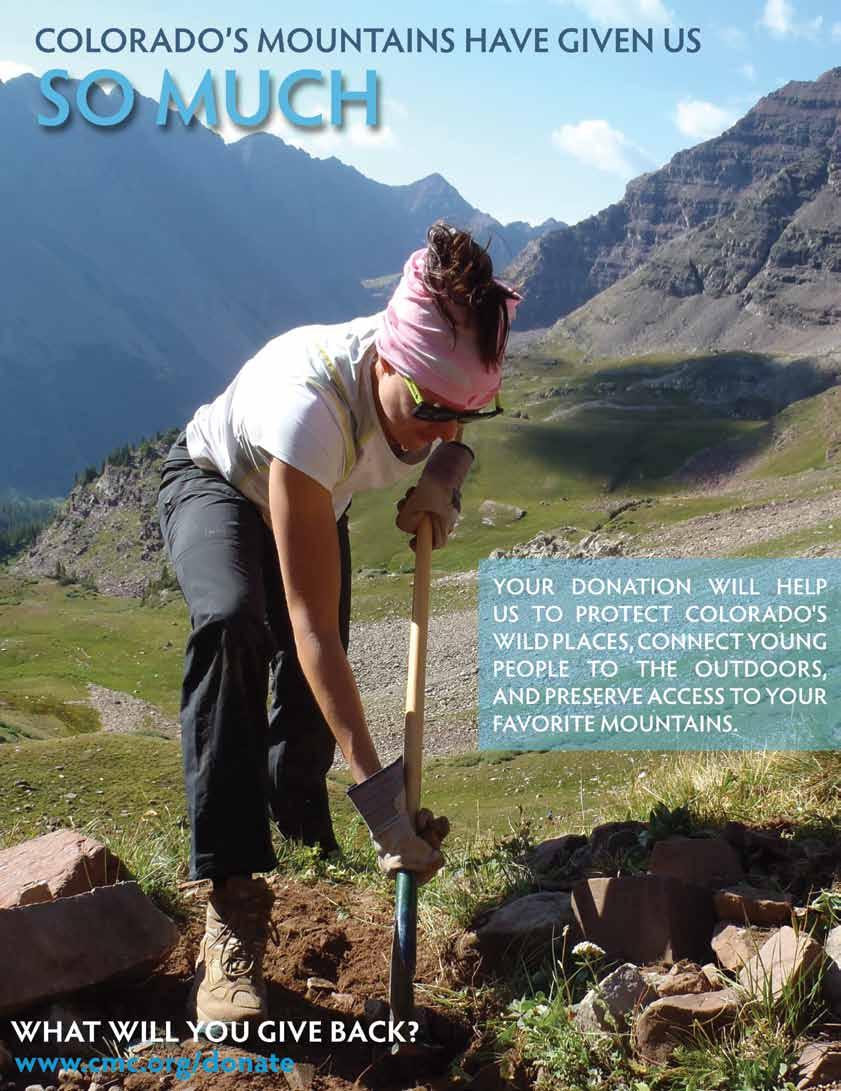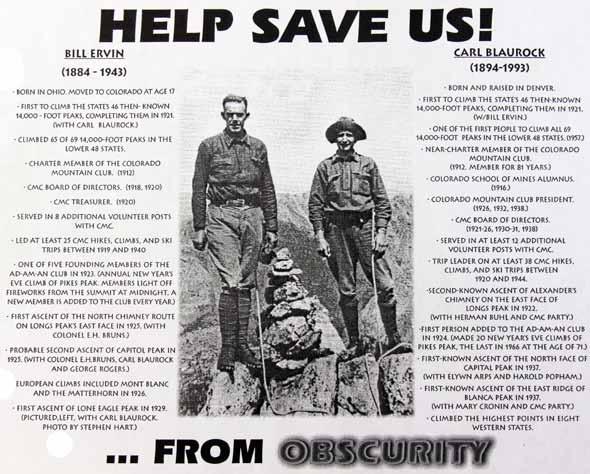
17 minute read
so you Want to name a mountain…?
By Woody Smith
“In the Wilderness Act of 1964 Congress established the National Wilderness Preservation System composed of federally owned areas to be administered ‘...for the use and enjoyment of the American people in such manner as will leave them unimpaired for future use and enjoyment as wilderness….’
Though wilderness designations are a modern invention, a fundamental characteristic
of elemental wilderness is that features are
nameless and the cultural overlay of civilization is absent. No wilderness is today totally free of placenames and cultural artifacts, but a goal of Federal wilderness area administration is to minimize impacts and traces of people.” United States Board on Geographic Names. Principles, Policies, and Procedures: Domestic Geographic Names, Chapter 3, Policy IV— Wilderness Names. Back around the turn of the last century I had the bright idea of naming adjoining peaks for Carl Blaurock and Bill Ervin, the first two people to climb all of Colorado’s known 14,000-foot peaks. They finished the 46 known peaks in 1923, climbing “new” Fourteeners as measurements improved.
The peaks that seemed appropriate were two of Colorado’s highest unnamed twin summits, the 90th and 99th highest in the state. Unnamed 18,832 (proposed Mt. Blaurock) and Unnamed 13,811 (proposed Ervin Peak) are located in the San Juan Mountains about 10 miles west of Lake City, near 14,000-ft. Redcloud and Sunshine Peaks.
But there were two obstacles. First, the two unnamed peaks are in the Redcloud Wilderness Study Area, and the 1964 Wilderness Act prohibits naming, without good reason, in Wilderness Areas, or areas under study for wilderness designation. Second, another party had recently proposed a different, smaller, “Mt. Blaurock” in the Sawatch Range.
Despite attempts to join forces with the other party and try to get the big peaks for Blaurock and Ervin, my efforts were rebuffed. However, soon an adjoining Ervin Peak was added to the other proposal. Faced with two proposals for Blaurock and Ervin, the U.S. Board on Geographic Names (USBGN) chose the non-wilderness peaks.
As it stands, Blaurock and Ervin have been relegated to the 186th and 234th, rather than the 90th and 99th highest peaks in the state—an outcome that remains inadequate. Feel free to fix it.
Prior to the Blaurock-Ervin decision,
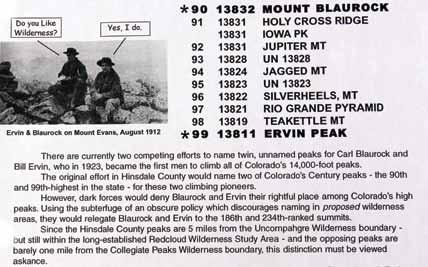
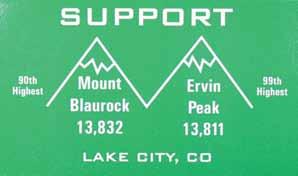
▲ Refrigerator magnet from the 2003 effort to name wilderness area peaks for Blaurock and Ervin. Courtesy David Hite
100 Years Ago! Toponymics in 1914
1914 was a good year for toponymics—naming the land—in Colorado. In May, CMC founding member Ellsworth Bethel officially proposed names for what are now the Indian Peaks in the northern Front Range to the U.S. Board on Geographic Names. Of 11 names proposed, 6 were accepted.
In July, Harriet Vaille’s plan to have Araphoe elders tour the proposed Rocky Mountain National Park, to find out what they used to call things, came to pass. Named landmarks were thought to help the Park’s chance for approval.
In October, Colorado’s own Geographic Board was formed under the direction of the CMC’s co-founder and first president, James Grafton Rogers. A busy guy, Rogers was named the new board’s chairman, appointed by Governor Ammons himself. Ellsworth Bethel was also named to the board’s executive committee. Harriet Vaille was the board secretary. Rogers took his toponymics seriously. He compiled a cross-referenced file of Colorado place names the old-fashioned way—on thousands of index cards. The microfilm copy at the Denver Public Library fills nearly six rolls. Rogers also named Mts. Cirrus (12,797’), Cumulus (12,725’) and Nimbus (12,706’) in the Never Summer Range. For the full story of toponymics at Rocky Mountain National Park, read “High Country Names” by CMC members Louisa Ward Arps and Elinor Eppich Kingery (T&T, 1972).
I had also submitted a proposal to name Unnamed 13,870, Colorado’s 75th highest summit, for Mary Cronin, who was the fourth person and first woman to climb all the Fourteeners, finishing in 1934. (Blaurock and Ervin updated their “lists” on the same trip.)
Naming four of Colorado’s Centennial Peaks—the 100 highest—for the first four people to climb all the Fourteeners, seemed like a good goal: Mt. Ellingwood (14,042), named in 1970, honors Albert Ellingwood, third on the list.
A year and a half after the BlaurockErvin decision, I received a letter from the USBGN: Cronin Peak had been approved!
It seemed ironic; I had merely written a proposal for Cronin Peak, while promoting Blaurock and Ervin as much as possible. I wrote letters, made phone calls, enlisted people in Lake City, and even designed fliers and magnets.
Flush with unexpected success, I proposed names for two other peaks. The first, for Agnes Vaille, adjoined Cronin Peak. Vaille was on track to finish the Fourteeners when she died on Longs Peak in January 1925. Since Vaille and Cronin had been climbing partners in the early ‘20s, the dual peaks seemed appropriate.
The other was a proposal for Unnamed 13,799 near kit Carson Mountain, informally known as Obstruction Peak because it’s in the way for climbers on their way to kit Carson.
With recently named Challenger and Columbia Points in mind, I proposed Galaxy Peak, with John Schuessler, a retired NASA contractor, and co-founder of MUFON (the Mutual UFO Network). Unfortunately, the summit of this mountain is about one-third of a mile inside the Sangre de Cristo Wilderness, which of course spelled doom for the proposal.
I did think Mt. Agnes Vaille had a better chance, but the USBGN voted no. There was already a waterfall near Mt. Princeton and a storm shelter on Longs Peak named for her.
With the future clear, we withdrew Galaxy Peak before it was voted into a black hole.
Thus, my peak naming record is mixed, yet evenly distributed. △
1 - Approved 1 - Disapproved 1 - Diminished 1 - “Borrowed,” then diminished 1 - Withdrawn
Rosina Anna Spray ▶ 1935-2014
By Kirstin Jensen
We thought Rosina would be with us forever; she led the pack in her passion for hiking, snowshoeing, skiing, and biking, not to mention walking. She preferred to go by foot rather than drive for errands far and wide, and all this done with great pleasure and enthusiasm.
But that was not to be and Rosina passed away on July 2 after a short illness. She was born in Arlesheim, Switzerland. Rosina lived with her family in multiple communities both before and after earning her RN degree, including working in Zimbabwe when her boys were young. She is survived by her son Selwyn Spray, granddaughter Aryah Spray, brother Wilfried Rauser, and former husband Dr. Selwyn Spray. She is predeceased by her son Ruedi Spray and brother Ruedi Rauser.
Rosina will be remembered for her lifelong love of the mountains and her passion for all things active and outdoors. As an active participant in CMC’s Over the Hill Gang outings, she infused the group’s hikes and snowshoe trips with her cheerful and intrepid nature. She enjoyed biking with groups and awed us all with her numerous Ride The Rockies tours, where she, of course, would “never use the sag wagon”. Rosina was definitely not a “sagger”!
Rosina’s energy and dedication extended far beyond her outdoor activities. She lived a life of selfless service to family and friends. She was a great support to her son and granddaughter. Her Swiss heritage was important, and was shared with her family. She was a board member of the Swiss-American Friendship Society and organized their annual independence day celebration, incorporating all things Swiss into the event. She led their annual Father’s Day hike, providing the food as well as the leadership—her last trip being only a few weeks ago, when she focused on the enjoyment of the participants rather than her unfamiliar decrease of energy. Other volunteer commitments included making regular deliveries for the Meals on Wheels program and active support of her preferred political candidates.
We will not forget Rosina. She touched our lives and those of others in so many ways. A celebration of life service was held on July 13th. △
◀ Rosina Spray. Courtesy of Gordon Cook
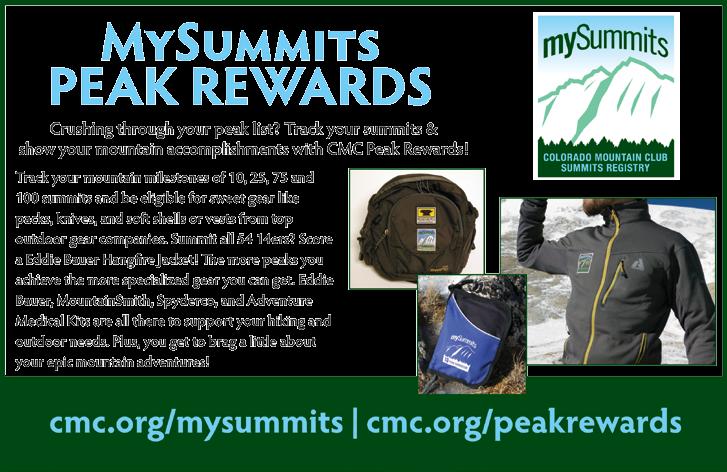
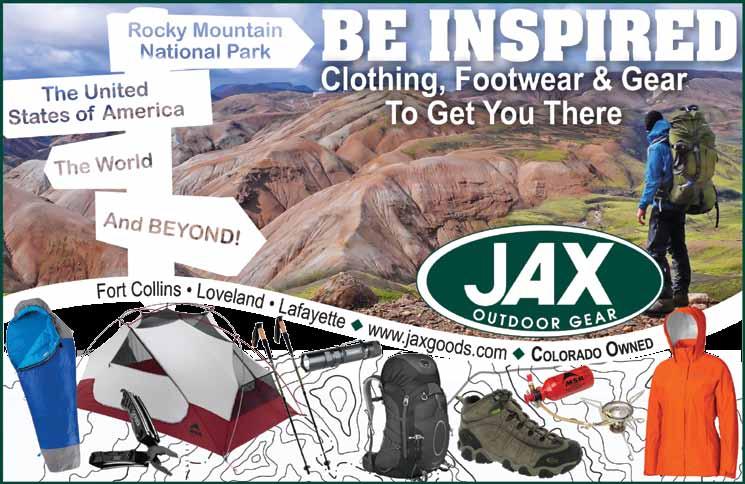

For your benefit and enjoyment, the following trips have been reviewed and approved by the Adventure Travel Committee and are officially sanctioned by the Colorado Mountain Club.
Visit www.cmc.org/AdventureTravel for more detailed itineraries and registration forms.
Best Hikes of Italy September 14–26, 2014 CMC Members: $3,950
Explore three distinctly different areas of Italy as we hike in the Italian Dolomites, trek in the hills above Lake Garda, and experience the trails connecting the Cinque Terre, five beautiful villages on the Italian Riviera. Starting in Milan, Italy, we transfer to Balzano to tour the (Reinhold) Messner Museum, followed by three days of hiking in the towering Dolomites. Next, we transfer to beautiful Riva del Garda on Lake Garda. In addition to two day hikes, there will be opportunities for recreation, including beautiful beaches, boat rides, formal gardens, and more. One evening we will enjoy an Italian cooking class. We will transfer by train to Cinque Terre and stay at a charming 4-star inn. We will hike the trails that connect these villages. On our return to Milan, we will visit Leonardo da Vinci’s The Last Supper. Throughout the trip, we will enjoy the delights of Italian cuisine in charming restaurants and pubs. Hiking level will be B and C level over 6–7 days. The trip includes 12 nights’ accommodation in small elegant hotels in Bolzano, Lake Garda, and Monterosso, Italy. The maximum number of participants is 12, plus leaders Terri Morrow and Linda Ditchkus, for a total of 14. Trip cost covers all ground transportation, guided hiking in the Dolomites, 12 nights’ accommodation, 11 breakfasts and 11 dinners, and lunch on hiking days, along with cultural events—Messner Museum, cooking class, and The Last Supper. International airfare (estimated at $1,000–1,200) is not included. Also, expect to spend a few hundred dollars on trip insurance, souvenirs, bar tabs. Non-members pay an additional 3% administrative fee.The trip is currently full, but please inquire with Terri at morrow.terri@gmail.com about being added to the wait list.
Great Smoky Mountains National Park October 18–26, 2014 CMC members: $1,000
Please join us for another epic adventure in the Southern Appalachians! Experience one of the most biodiverse regions in the United States and discover its incredible beauty. If your bucket list includes visiting Great Smoky Mountain National Park, then wait no longer! your trip leader has lived and hiked in these mountains for over a decade and will take you to some of the coolest places in the park at one of the prettiest times of the year: Mid-October is prime fall foliage season in the Southern Appalachians. The planned itinerary is to spend six or seven days exploring Great Smoky Mountains Park, including touring, a lot of hiking, and an optional bicycle tour around Cades Cove one morning. We will do day hikes throughout the western half of the park (some hikes will be on the Appalachian Trail) and will take the weather into consideration to try to pick a good destination every day. While participants are expected to be in shape to participate in all hikes, the trip is designed to allow individuals to stay at the cabin for a leisure day if needed or desired. If possible, we will spend our last night at Charit Creek Lodge in Big South Fork National Recreation Area near the kentucky border. Charit Creek is a historic and very rustic hike-in lodge with one-room log cabins that sleep 12, a solarpowered bathhouse, and a historic dining room for dinner and breakfast (included). Charit Creek Lodge requires full payment up front and does not offer refunds. Whether we will be able to get a reservation depends on how soon this trip fills up! From the lodge, we will do an afternoon loop hike to the impressive twin arches (6 miles, 450 feet). Our base in the Smokies is a cabin in Townsend, Tennessee, just yards from the national park boundary. Townsend touts itself as the quiet side of the Smokies. As the old timers continue to turn over the reins to the younger generation, Townsend is becoming less “quiet” and more commercial every year. But, as you will see when we visit Gatlinburg one evening, Townsend still is a fabulously quiet place! Our cabin has five bedrooms and three bathrooms, a screened-in porch overlooking the creek, a deck with a hot tub, a wood stove, a full kitchen, washer and dryer, etc. While at the cabin, we will be responsible for preparing ALL our meals—breakfast, sack lunches and dinners—unless we decide to go out to eat. The trip fee includes funds for the group meals. Every participant will be required to actively participate in meal planning, grocery shopping, cooking, and cleaning up. If we can get a reservation for Charit Creek Lodge for our last night, we will say goodbye to our luxurious cabin on day eight and drive about 150 miles to the trailhead for our 1-mile hike to the lodge. Otherwise, we will stay at our cabin one more night and find something fun to do in the Smokies. The trip starts and ends at the airport in Nashville. Airfare to and from Nashville is not included in the trip cost. your trip cost includes all ground transportation in Tennessee, all overnight stays, as well as group meals at the cabin and Charit Creek Lodge. Any meals we choose to eat out are on your own. If interested, contact Chris Dohmen at cattanooga@gmail.com
World Summit Series: Mt. Kosciuszko, Australia and Tasmania, 2015 February 20–March 8, 2015
Visit Sydney and kosciuszko National Park, climb kosciuszko (one of the Seven Summits), and visit Tasmania with four days of guided walks to alpine and coastal regions on this beautiful island. The maximum number of participants is 10, plus two CMC leaders. Accommodations will be hostels with dorm-style sleeping, and cabins with shared rooms. Travel will be in shared vans. The trip is not technically demanding; participants must be able to hike up to 12 miles round-trip (approximately a hard C hike), and must have appropriate alpine trekking skills (knowledge of how to dress for potentially cold and windy conditions). A pre-trip information meeting and pre-trip hike will be held in November or December. All lodging; park entry fees; incountry transportation, including air travel between Sydney and Tasmania; and an allinclusive cabins, transportation, day hikes and food package in Tasmania are included in the trip fee. Not covered in the trip fee are airfare between US and Australia, Australian visas, most meals, personal gear, and expenses for optional trips in Sydney. Prices for hostels, van rental, and leader fees may vary depending on the number of participants signed up. If interested, contact leaders Bob and Sharon Dawson at marmetsharon@msn.com or robinmtns@yahoo.com.
Grand Canyon Raft and Hike, 2015 April 25–May 7, 2015 CMC members: $4,465
This unique trip to the Grand Canyon offers participants the opportunity to experience this World Heritage Site on a motorized raft for 188 miles through the best of the canyon, departing from the historic Lee’s Ferry and ending with a helicopter ride from Whitmore Wash and a plane flight back to the start. It is especially ideal for those who would like to hike in areas that can be reached only from the river, and those who have always wanted to experience the canyon but who do not wish to make the 7 mile, 4,500’ trek in and out. The Grand Canyon, designated a World Heritage Site by the United Nations in 1979, is among the Earth’s greatest ongoing geological spectacles. About 65 million years ago in Earth’s shifting, a huge area of land was lifted a mile and a half above sea level, forming what is now the Colorado Plateau. For the last 6 to 10 million years, the Colorado River has been slowly carving its way down through the center, exposing 2 billion years of geological history. There are also prehistoric traces of human adaptation to a particularly harsh environment. Our outfitter, Hatch River Expeditions, has been guiding river trips through the canyon for over 75 years. We will have 4 guides and 20 participants on two 35’ S-rig boats running 30 hp 4stroke outboard engines (fuel efficient and quiet). Each boat holds 18, so for this trip we will have plenty of room. An average motorized raft trip through the Grand Canyon is for 7 days with short daily hikes. Hatch is adding 5 days to the trip with over 100 possible hikes, depending on the group’s interest and the weather. They offer us daily guided hikes at different hiking levels, or one may choose to rest in camp. There are several opportunities for point-to-point hikes where we may hike from one drainage to the next and the raft will pick us up later in the day. For maximum enjoyment, one may wish to participate in several CMC hikes prior to the trip. The hikes will vary in difficulty from levels B and C. In general, a couple hiking levels will be available on most days.There is always the option to take the day off and rest in camp or at the river. All of our hiking will take place below the altitude of Denver (the river is at about 2,500 feet). Because this is the desert, one must be able to adapt to the heat and cold. Some of the hikes offered will be full day hikes of significant distance and altitude gain. Many hikes may follow a social trail or are off trail. Hatch provides all meals, snacks, eating utensils, life jackets, tents, cots, camp kit, camp chairs, and arranges the helicopter and plane rides back to the put-in.The camp kit includes a sleeping bag, pillow, sleeping pad, ground cloth, and waterproof bag.The park entrance fee is included. The cost of the trip also includes all tips and one night (double occupancy) at the Cliff Dweller’s Lodge near the put-in on Saturday (4/25/15). Trip deposit of $500 is payable to the CMC at time of registration ($300 of this deposit is non-refundable). Final payment is due November 14, 2014. For cancellation on or before November 14, 2014, there will be a refund of $200 ($500 less the $300 non-refundable fee). Any refunds for cancellations after November 14, 2014, will be made only if a qualified replacement is accepted. Travel insurance is recommended. Please contact leaders for availability and/or wait list at 303-8710379 or blakerosemary@cs.com
Scotland’s West Highland Way and Ben Nevis Climb, 2015 May 13–26, 2015 CMC Members: $3,040
Hike Scotland’s West Highland Way for 95 miles beside lochs, waterfalls, and craggy mountains in the Scottish Highlands. This famous route is walked by over 50,000 people each year, making it the most popular long-distance walk in Scotland. The path uses ancient roads, including drovers’ roads, military roads, and old coaching roads. We will walk the traditional route from south to north to the foot of Scotland’s (and the U.k.’s) highest peak, Ben Nevis. The group will attempt a climb to the summit of “the Ben” (4,409 feet), weather permitting. Although hiking will be the trip’s focus, the group will also tour medieval Edinburgh, Stirling (famous for being the home of William Wallace), the Eliean Donan Castle in the Scottish Highlands, and a Scotch distillery. This trip includes 10 days of hiking; only fit participants will be accepted on the trip. The West Highland Way will take nine days of hiking from village to village in the Scottish Highlands, with distances ranging from 7 to 16 miles per day. The final day of hiking, an attempt to climb Ben Nevis, will be 12 miles roundtrip on good trails to the 4,409’ summit (about 4,300’ of gain). This climb is straightforward and typically not difficult, but weather in the Scottish Highlands can change quickly and safe descent routes can become obscured in foggy conditions. Both leaders have experience climbing this peak. The maximum number of participants on this trip is 14, including the two co-leaders. Accommodations will be small hotels and B&Bs along the walk and 3-star hotels in Edinburgh. If interested, contact Linda and David Ditchkus at lvditchkus@hotmail.com.
